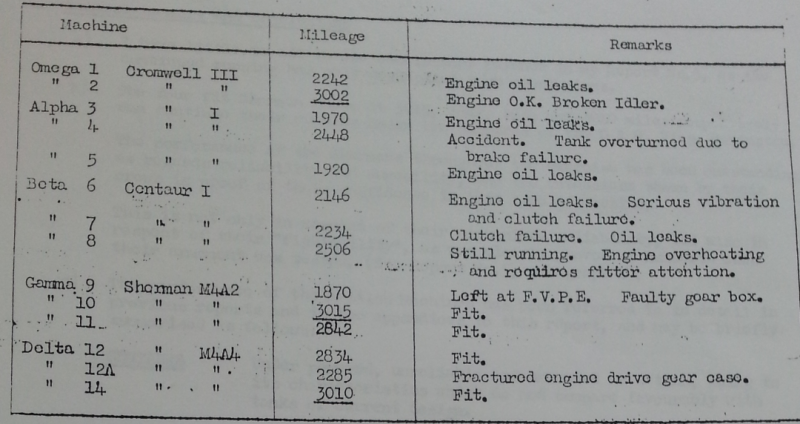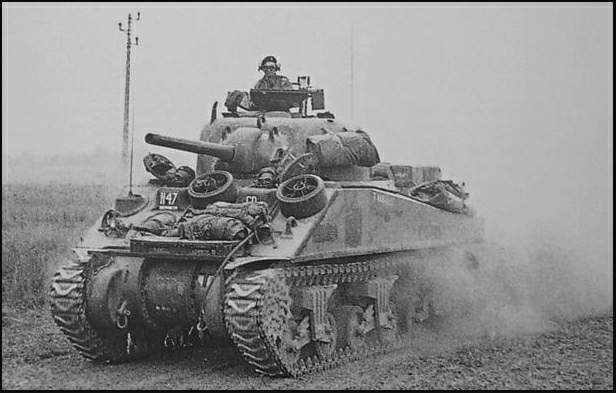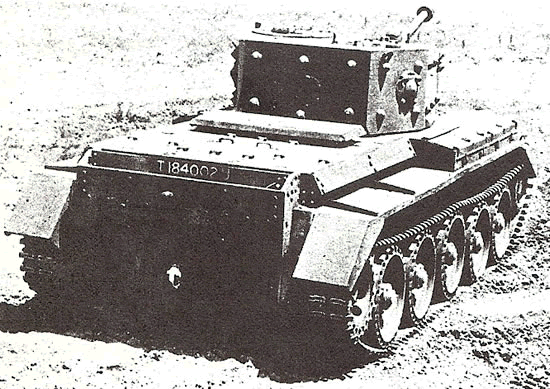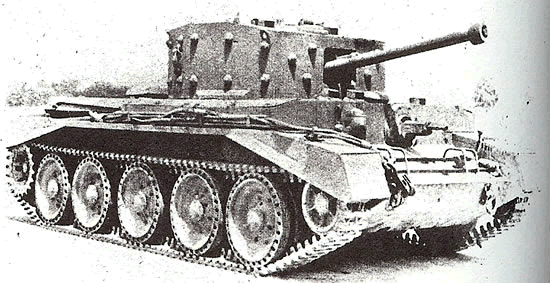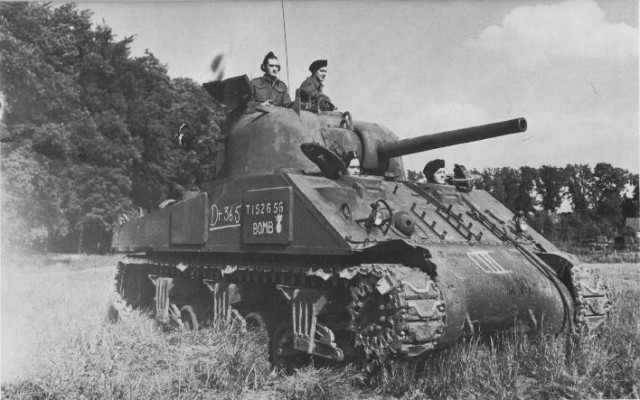A little while ago, you will recall, I came across a report of comparative testing between two British cruisers (Centaur and Cromwell) and Sherman in the US The British vehicles did not come across well. There was some speculation on the forum that perhaps there was a little national bias in the report, and that also there may have been issues with unfamiliarity with the foreign equipment. Well, I was doing a bit of digging in the British archives, and found an interesting counterpoint.
Firstly, a letter from a British observer, a chap named Alec Richardson, presumably of the British Tank Mission. Letter dated 15th October 1943, amongst other topics, there’s a section entitled “On Centaur and Cromwell”. I quote:
These tanks have made us a laughing stock out here. The Cromwell has had a variety of troubles, and it was mad only sending out only one of each. The Americans are politely indifferent to what happens to them and Waller, the Rolls Royce man with them, is most unhappy and wants them withdrawn as soon as possible. We are undoubtedly the world’s worst salesmen!
I strongly advise we send out no more British tanks until they are reliable, and then, when we do, we send out about two trained troops with a first class officer in charge of them.
We have lost a lot of prestige over these pool lone derelicts.
Finally, and I consider this most important, WE MUST MAKE A FIRST CLASS CRUISER AND LIGHT TANK AT HOME, however long it takes us. The new Cromwell should fill the interim, for, say, the next year or two, but WE MUST REGAIN OUR PRESTIGE.
The Americans have been a bit in the doldrums lately with their T.20s, but they will emerge and produce the goods in due course.
This is our chance to get ahead of them, but we must redesign, and not be content with botching up an obsolescent type
Forgive me for being so didactic, as I feel it’s mainly my fault we haven’t got a good tank now!
Whether he felt the sample size was representative or not, in any case he makes no mention of perceived national bias. There is, however, a control case. There is a rather large file in the British archives about an “Exercise Dracula”, in which the British Army, between 04AUG43 and 22SEP43, ran a full squadron of tanks against each other. At least 2x Cromwell III, 3x Cromwell I, 3x Centaur I, 3x M4A2 and 3x M4A4. The final report, marked “Most Secret”, was filed by Major General A.C. Richardson.
The first ten days of the exercise was preparation and checking of the vehicles at Bovington. Then, 15AUG to 12SEP were road and cross-country trials round England, returning to Bovington after approximately 2,000 miles. The remainder of the exercise was “intensive road and cross-country running in the vicinity of Bovington”
The General noted:
Owing to the enthusiasm and keenness displayed by all ranks, and the competitive spirit between crews to achieve the maximum possible performance of their own particular machine, it must be assessed that the results are probably better than would have been the case under active service conditions, where the amenities such as concrete standings, blacked out workshops, etc, would not have been so readily available.
In order that the exercise should not be unduly delayed, it was decided to close down when one machine of each type reached 3,000 miles.
This was not possible in the case of Centaur as the top mileage machine was only 2,516 when the Cromwell and Shermans reached 3,000 miles, and the state of the machine was such as to preclude further running without major fitter attention.” [Note to Americans: “Fitter” is English for mechanic]
The final conditions of the vehicles was as follows:
He continued:
“Special attention is drawn to the [table which shows] the comparative man-hours of specialist fitter attention required to keep the various types of machines on the road”
Yes, I know it says 5 Centaurs and only 3 are listed in the earlier table. I have no explanation, and neither is one given in the report. Possible it was just a typo. Interestingly, the appendix pages also make references to Cromwell Xs, without saying where they came from. I am fairly convinced that the entire report was not in the box.
Anyway, his overall opinions.
The performance of the Shermans throughout the exercise has been outstanding as regards reliability and durability, and the enthusiasm shown by their crews is proof of their confidence in this type of machine. This is not only in respect of their mechanical reliability, but also in respect of their “fightability”, as was clearly proved at Lulworth when their armament was tested.
Centaurs: Underpowered, unreliable and unwanted as a tank, owing to its characteristics which do not compare favourably with tanks of current design.
Cromwells: Spectacular as regards speed, but doubtful as regards maneuverability and control, owing to unreliability of steering and brakes. Doubtful as regards durability over 2,000 miles, owing to the stresses and strains experienced by the Meteor engine when mounted in the hull of a tank and subjected to reverse torque, which an aero engine is not normally called upon to do
Should the Cromwell be made entirely reliable mechanically, there is still the question of its “fightability” to be considered as at present its gun mountings and accessories leave much to be desired
I’m not going to go into the various details of the failings the various vehicles suffered, but a general overview can be found here:
Some observations by the records keepers.
Oi/c Cruiser records, name not provided, stated, inter alia:
Cromwells: The performance of these machines was very disappointing as, without exception, the failures were all old troubles experienced before, and, one might have hoped by now, ought to have been rectified. With nearly all crews this was their first introduction to the Cromwells and it was obvious after the first few failures that the drivers had lost confidence in this machine. However, from a purely driving angle, all crews agreed that it is a beautiful tank to handle, and the power unit of 600hp is a definite step forward in design.
Centaurs: These machines up to about 1,500 miles put up an improved performance in comparison to earlier machines. The biggest surprise being the clutch which now appears serviceable, whereas in our previous experience 800 miles was the limit before the races broke up in the cam box. The engine is still far from oil tight with the result that radiators have to be cleaned constantly. Petrol starvation was another constantly recurring trouble. […] One can only hope that units are receiving these machines for training purposes only.
Driving (Both). One of the biggest troubles with crews was their inability to adjust the brakes properly even when cold. This adjustment leaves much to be desired and when the vehicle is hot, medical attention is usually necessary for burnt arms, hands and necks etc. […] Two points of bad driving was constantly noticed. (1) overrevving (ii) bad cornering- usually trying to negotiate with (a) too high a gear or (b) with too few revs. Both of these points, to my mind, would be covered by a rev counter – an essential instrument conducive to good driving
His Sherman counterpart, a Captain Shaw, made the following observations, amongst others:
The Shermans on the whole were extremely reliable and gave very little trouble. All were fitted prior to the trial with rubber tracks and this in a large measure accounts for the little suspension trouble experienced during the trial. […]
On the M4A2 type the engines have given no trouble except for the initial failure of the two injectors on No 9. The injectors on all vehicles have not been touched except for checking for correct adjustment.[…]
On the M4A4 type little trouble has been experienced except for ordinary running maintenance jobs.
The next report in the packet was from a Major Ronald of the Westminster Dragoons, position un-stated. Excerpts follow:
Reliability: The outstanding lesson of this exercise has been to me the exceptional reliability of the American machines. All my ideas, based on 2 ½ years experience with an armoured regiment equipped with British machines have had to be revised, and though before the exercise started I was inclined to think that perhaps Sherman was somewhat overrated I am completely convinced of the superiority of this machine over anything that this country has produced up to date.
It is evident that the commander of a unit equipped with Shermans can be confident of taking 99% of his vehicles into battle, at any rate during the first 2,000 miles of their life. On the other hand, if he were equipped with Cromwells or Centaurs he would be in a continuous state of anxiety as to whether enough of his tanks would reach the battlefield to carry out the normal tasks expected of his unit.
Conditions of Trial:
The exercise has been run under conditions which have been very favourable to the machines and particularly so to the less reliable ones. Long mileages have been done, but […] the squadron has always reached harbor in time to carry out maintenance in daylight. […] Even so, the British machines have only been kept on the road by dint of much hard work. It is safe to say that such conditions are never likely to be encountered during operations, and less easy conditions will, of course, react unfavourably on reliability and battleworthiness.
Fitter and Light Aid Detachment Staff:
A fine result has ben achieved in bringing back to the starting point 13 of the original 14 starters after 2,000 miles around England. It must be remembered, however, that the Squadron has had the advantage of far greater technical assistance than is available to the normal armoured squadron. It is only this very lavish scale of fitters, L.A.D. etc that has enabled the Cromwells and Centaurs to be brought back to Bovington under their own power and even then much night work and long hours have had to be worked.
Design and erection
Taking a broad view of the exercise it appears that only a few defects can be ascribed to bad erection. Centaur governors and gear box oil seal on both Centaur and Cromwell should not have given trouble had erection and inspection been properly carried out and the many petrol stoppages are partly due to tanks having foreign matter in them on delivery
I suggest, however, that most of the troubles are really due to indifferent design. The radiator arrangement is simply asking for trouble and it is certainly a possibility that rod-operated steering control and re-positioned adjusters would go a long way to solve the steering troubles which were so frequent. The petrol tap is to the lay-mind a most unnecessarily complicated affair. The track adjustment on Centaur and Cromwell III is quite impossible from an operational standpoint and was, of course, tried out in a slightly simpler form on Covenanter and Crusader where it was never thought satisfactory by field units.
General conclusions:
The simplicity and reliability of the American machines in contrast with the British production is to me the chief lesson of Dracula. The Cromwell could, no doubt, be made into an equally good fighting vehicle but the re-designing necessary should, I suggest, have as its chief object simplicity which, in turn, will bring reliability.
The 2i/c, Captain Priestley of the Coldstream Guards, had a single page at the end, focusing on the sorts of things XOs focus on.
Cromwell: In theory the tank crews of this type should have had the easiest time in that, during the early stages of the exercise anyway, they were scheduled to arrive first.
In practice, however, on most occasions one or two of them arrived late at night, thus involving a late meal being required, guides being left out, petrol lorries being kept waiting and consequent loss of rest and sleep to a large number of personnel in addition to the tank crews themselves. It was also noticeable that Last Parade [American translation: After operations checks and services] took at least 1 ½ hours which was greatly in excess of the time taken by the Shermans and consequently the crews showed much greater signs of fatigue.
Centaur: The same remarks apply as to the Cromwell, only in a far greater degree. Numbers of personnel were kept up until the early hours of the morning waiting to feed and replenish the tanks. Arrangements were always being made so that fitters, etc, could work all night on them. Added to this they almost invariably left late in the morning, thus hindering the clearing up of the administrative area. If they had to be refilled with ammunition as well, they could never have kept pace with the rest of the column.
Sherman (diesel) 4A2
These tanks were no bother from an administrative angle. They often arrived before even the Cromwells – they never required refilling en route, their Last Parade was short and their crews always received their hot evening meal at the correct time. A full night’s rest was had by all and if it had only been a case of administering these tanks everybody would have had considerably more rest and sleep and dinners for all would have tasted much nicer owing to not having to be kept for long hours after they had been cooked.
Sherman (Petrol) 4A4
The same remarks apply to this type as to the other Shermans except that they took slightly longer to arrive. They did create one small problem in that owing to their heavier fuel consumption arrangements had to be made to refuel them en route when the remainder of the tanks could complete the distance quite comfortably without.
Conclusion:
In an exercise that is largely of a technical character it is easy to overlook some of the vital administrative points which stand out particularly when no actual fighting is being done. After considering the facts, however, it is plain that the crews of all Sherman tanks would have been 100% fighting fit on entering the battle area at any stage of the exercise. There would have been no extra problems in feeding and replenishing the crews and vehicles. The Cromwells, or a percentage of them, would have been tired with less sleep to look forward to and would have kept a large number of people busy in the harbor area most of the night.
The Centaurs would never have been at the right place at the right time and their crews would have been of little fighting value should they have had long approach marches or should they have been in action any length of time.
Finally, the words of the officer commanding, a Major Clifford.
Centaur: I should prefer not to take a squadron of Centaurs on active service. I consider it is underpowered and unreliable and require more maintenance in relation to running time than is justified. With good average crews and the best of technical knowledge and assistance available on this exercise it proved possible to get the Centaurs round most of the road work and some of the cross-country, but in a normal field squadron with no more than a fitter per troop and the rest of the Regiment’s demands on L.A.D and the Brigade’s demand on workshops, I do not think that one of them would have completed this operation and many would have had to be abandoned at an early date. The crew fatigue in fighting and maintaining this type of tank would be I consider an impossible handicap. This tank can be dangerous to its crew and other road users. We narrowly averted two bad accidents and unfortunately had one fatal crash which were all due to circumstances over which the driver had no control.
Cromwell
This tank has, in my opinion, the makings of a wonderful fighting machine but I do not consider it to be out of the experimental stage yet. For this reason alone I should not be entirely happy to take a squadron of Cromwells to war although I feel they would give an excellent account of themselves if properly handled. As was ordered on this exercise I would keep their maximum speed down to 30mph otherwise a host of track and suspension trouble could be expected; only on the rarest occasions and then in the fullest knowledge of what I was doing would I order a higher speed.
There appears much to be put right still and it is not the purpose of this report to trespass on technical grounds but I believe such points as improved cooling for brakes, a possibility of direct as opposed to hydraulic steering and a stronger suspension are now under test and will all assist to make this tank satisfactory for war. At the moment the relation of running time to maintenance, although nowhere near as high as Centaur, is I think a severe problem when crews must fight, drive and maintain for days on end. […] Crews are [..] confused, and uncertain and are definitely suspicious of the Cromwell’s steering reliability. […]
Sherman
There is little that I can say. This type of tank seems to be almost without reproach and personally I would be delighted to take a Sherman squadron to war. They are utterly reliable and have a magnificent gun which in my opinion are the two main considerations. I do not think they are quite as good as the Cromwell across country when they are running on rather worn rubber tracks and the going is greasy, neither does one get as smooth a ride, but they appear so infinitely superior in every other way particularly in reliability with a minimum of maintenance that this cross-country consideration is completely overweighed.
In some respects I feel that the Sherman carries rather too many electrical gadgets which occasionally give rise to trouble and it would appear that some of them could well be done away with without any detriment to the machine’s performance. Their slow speed (by comparison to the Cromwell) had very little effect on their time into harbor each night. This was largely due to the fact that they hardly ever had an involuntary halt and were able to keep a perfect distance and march discipline throughout the 2,000 mile run. Crew fatigue was at a minimum and maximum rest obtained.
[…] I would be glad to take a Sherman squadron to war tomorrow and a Cromwell after several month’s further trial and experiment.
Finally: On the firing trials at Lulworth it was found that only one tank of British manufacture was able to shoot without gun fitter attention, whereas all Shermans merely T and A’d their sights and drove up and fired all guns without a hitch.
Now, Dracula was only the first of two of such exercises. After a bit of tweaking, Cromwell was put through another round of testing a bit later, and it did a little better. The takeaways from this are firstly that Sherman had established and cemented a wonderful reputation with the British in 1943, especially in comparison with domestic machines, and secondly, that it is an indicator that the US Army’s testing of the British product was quite fair, not subject to particular bias, and a generally accurate assessment of the state of British vs American tank production.


